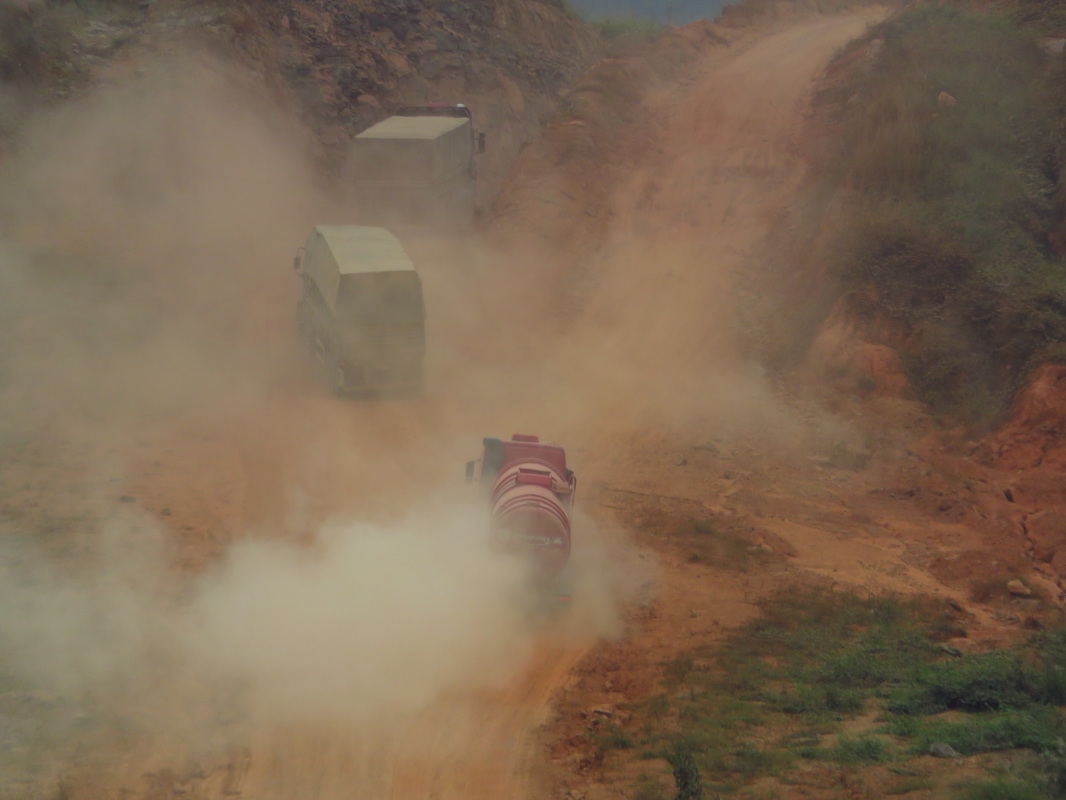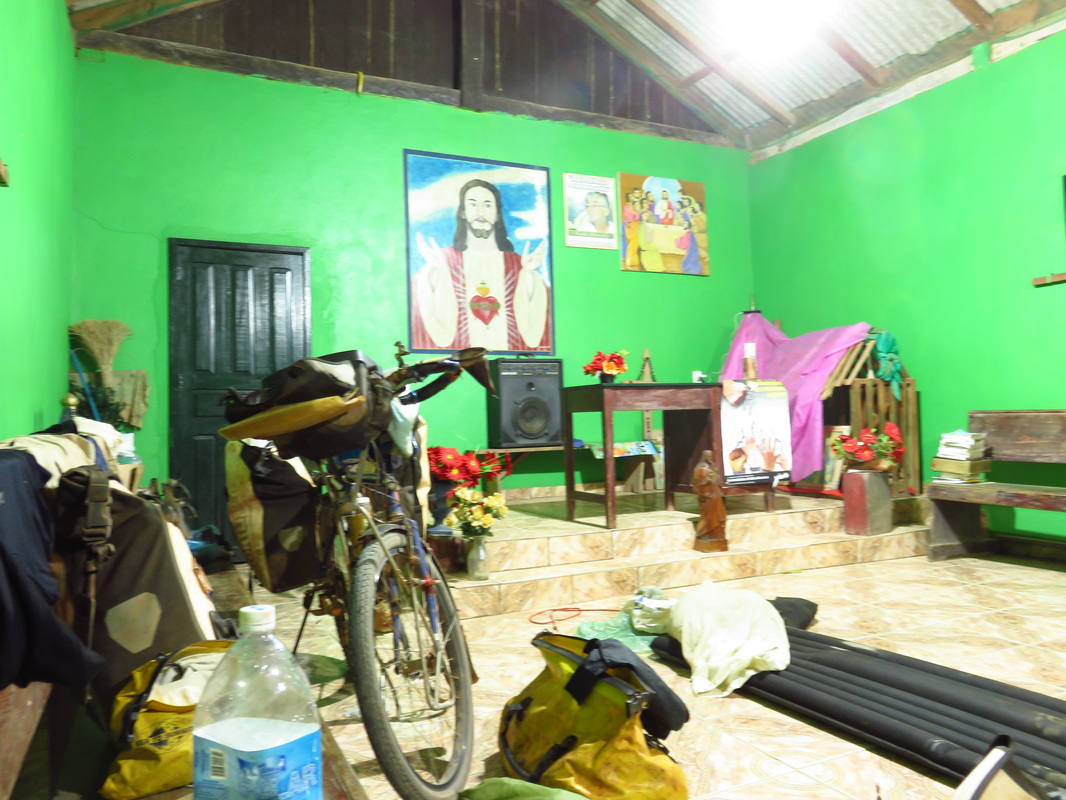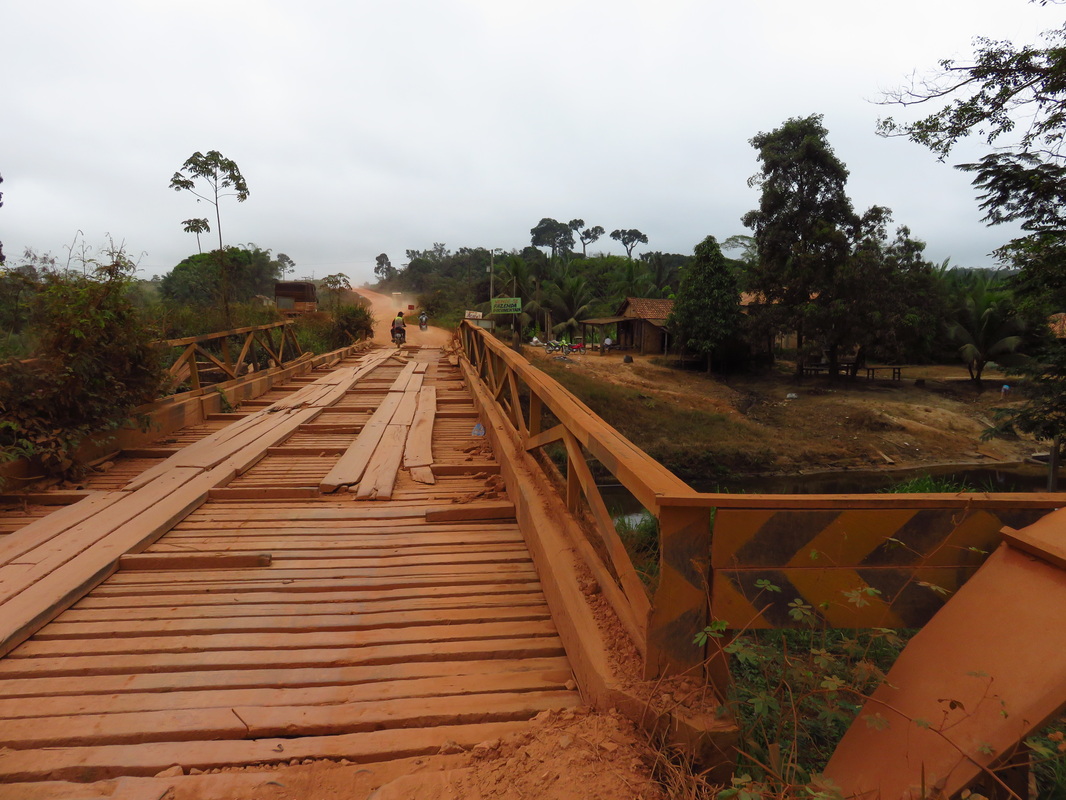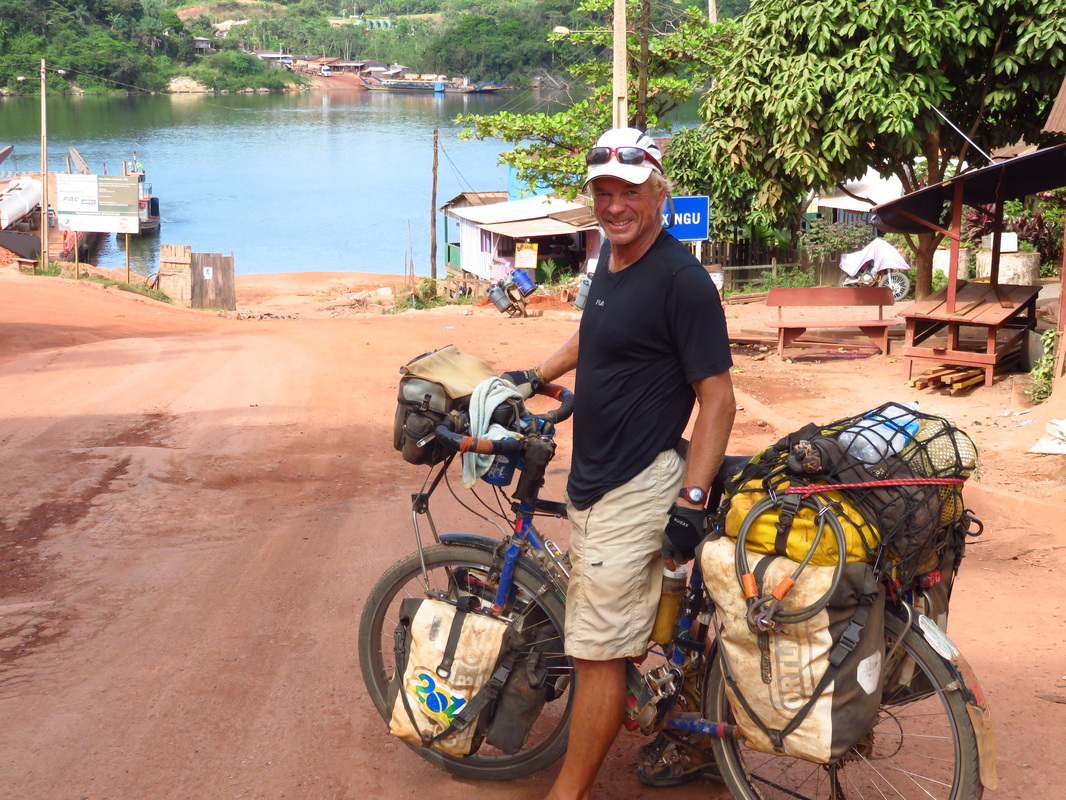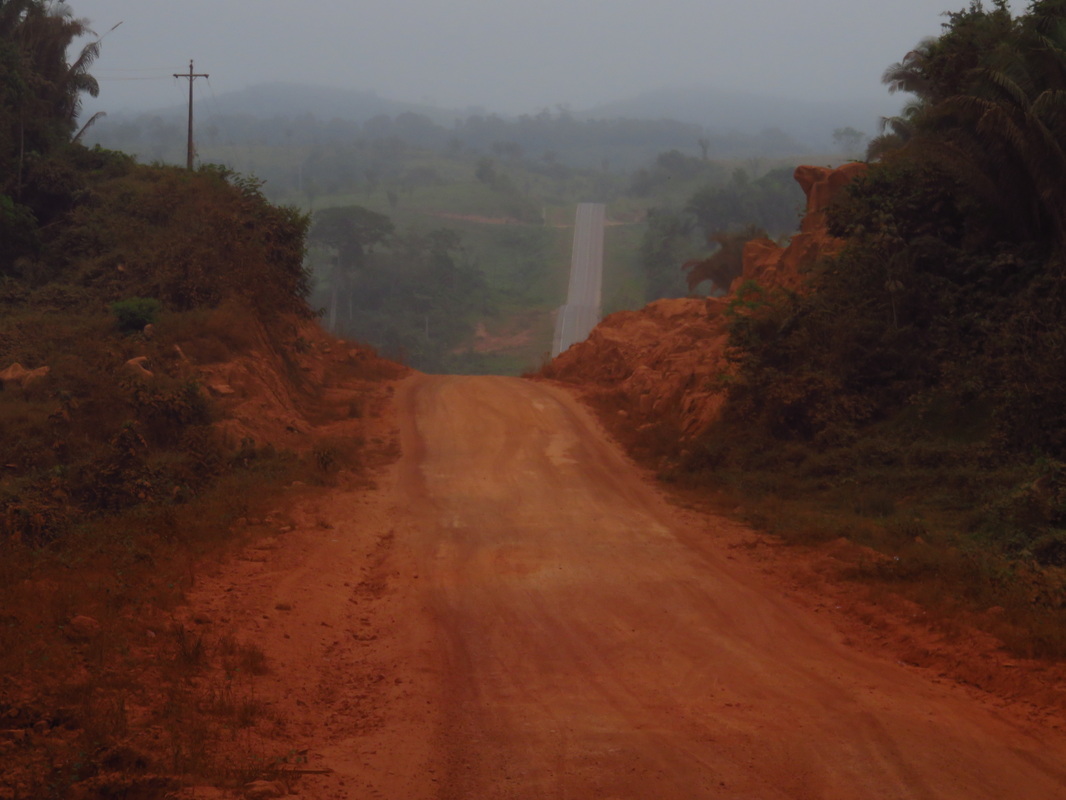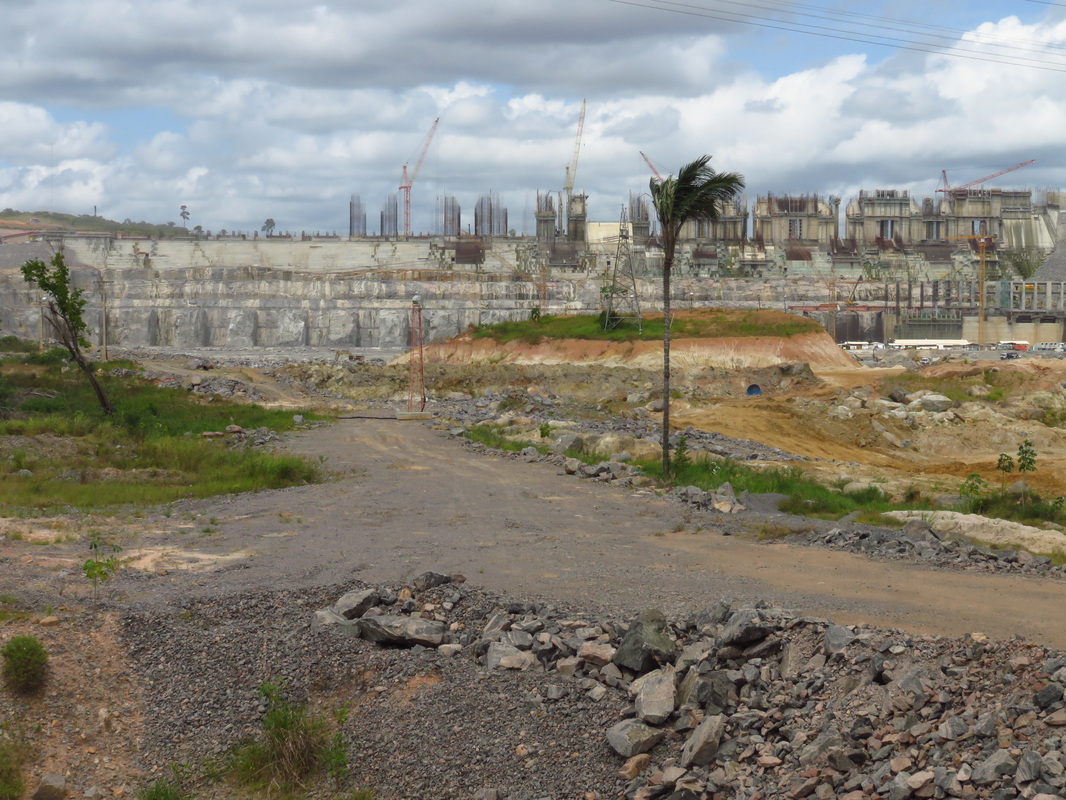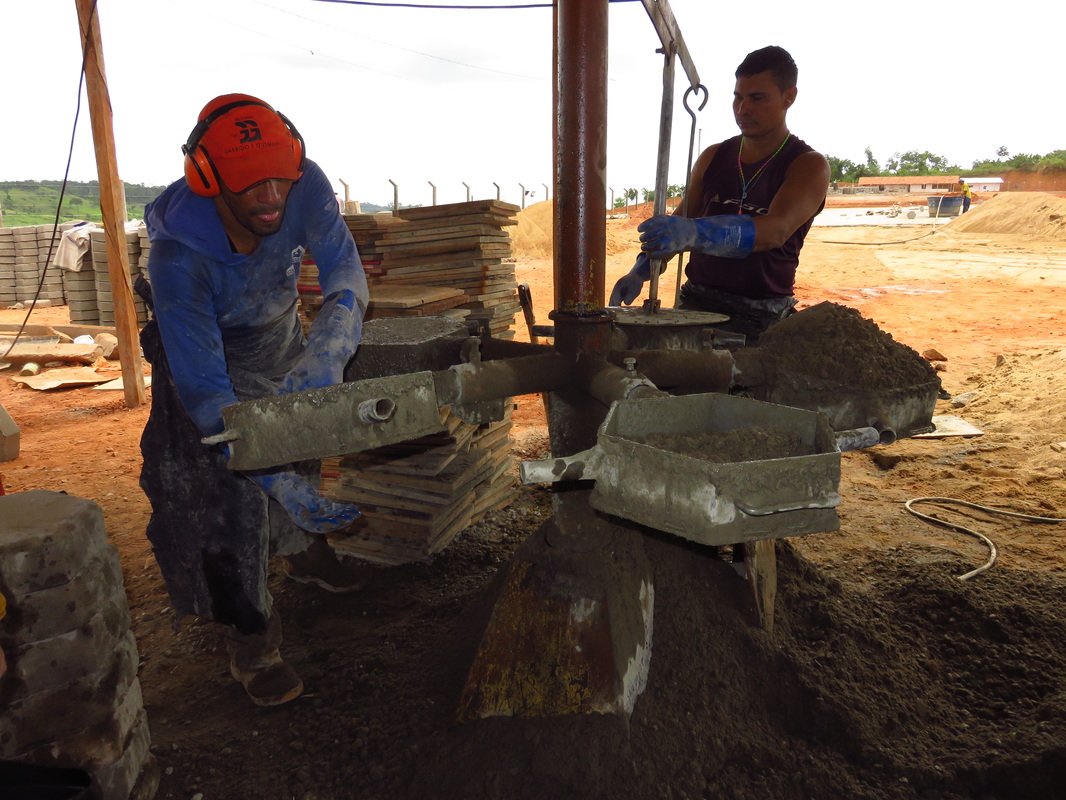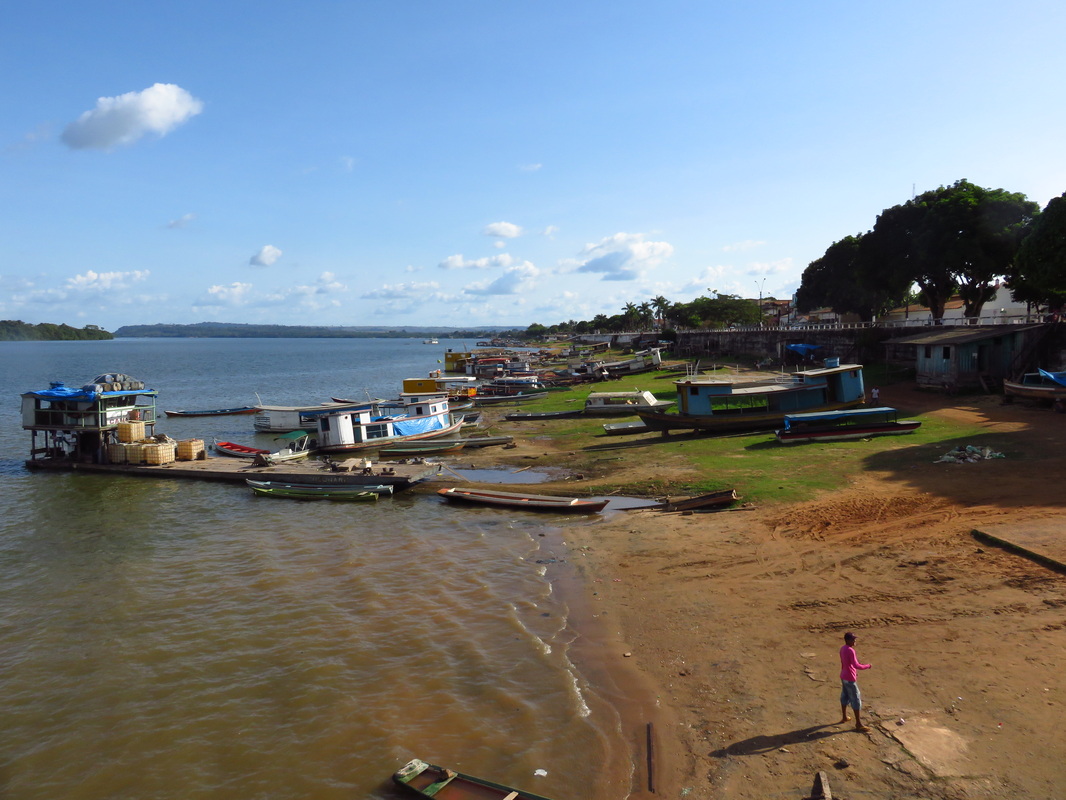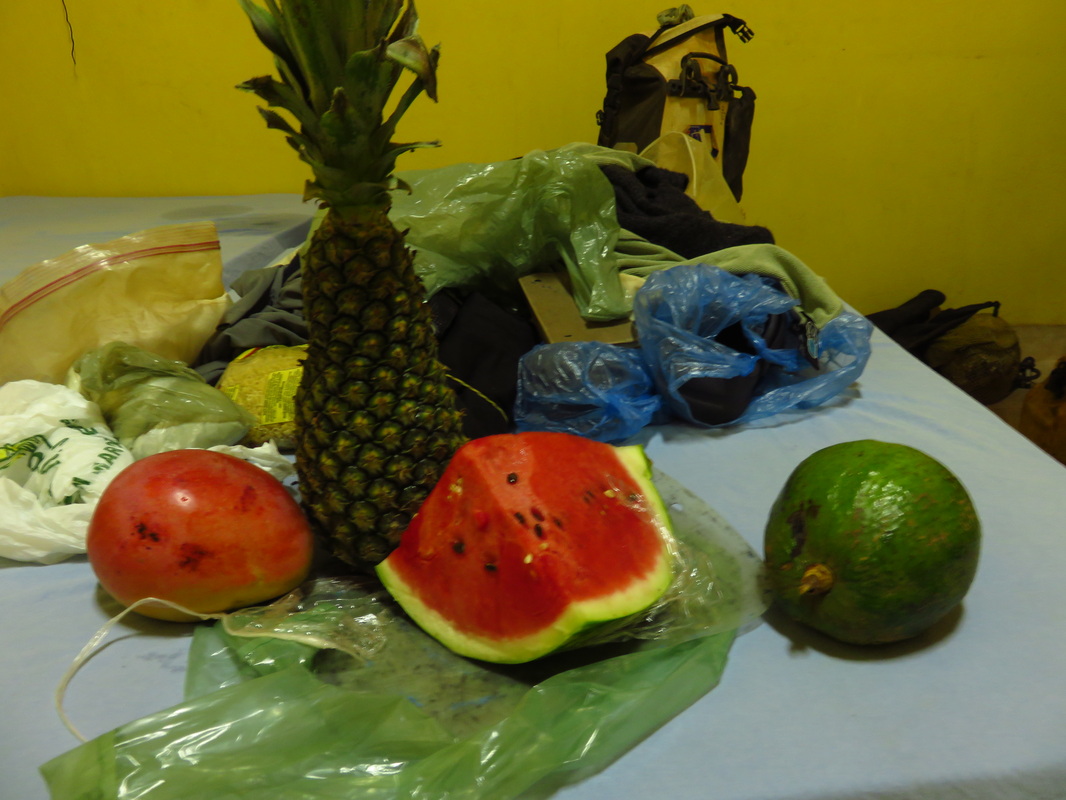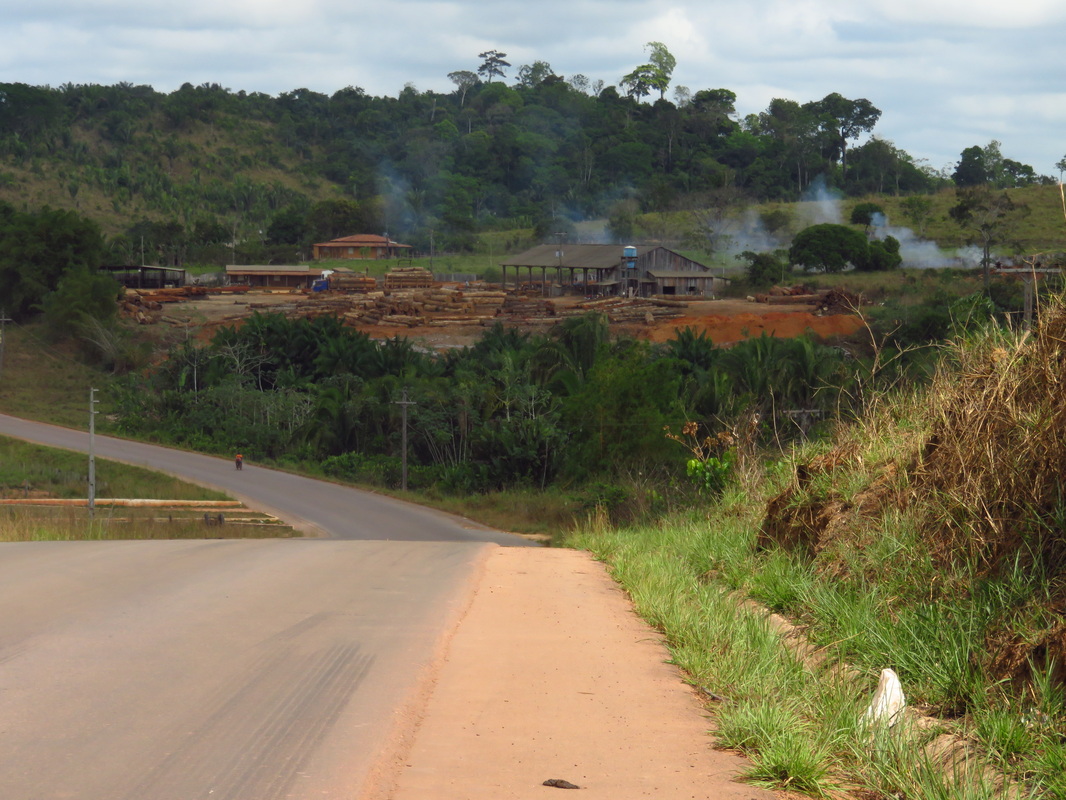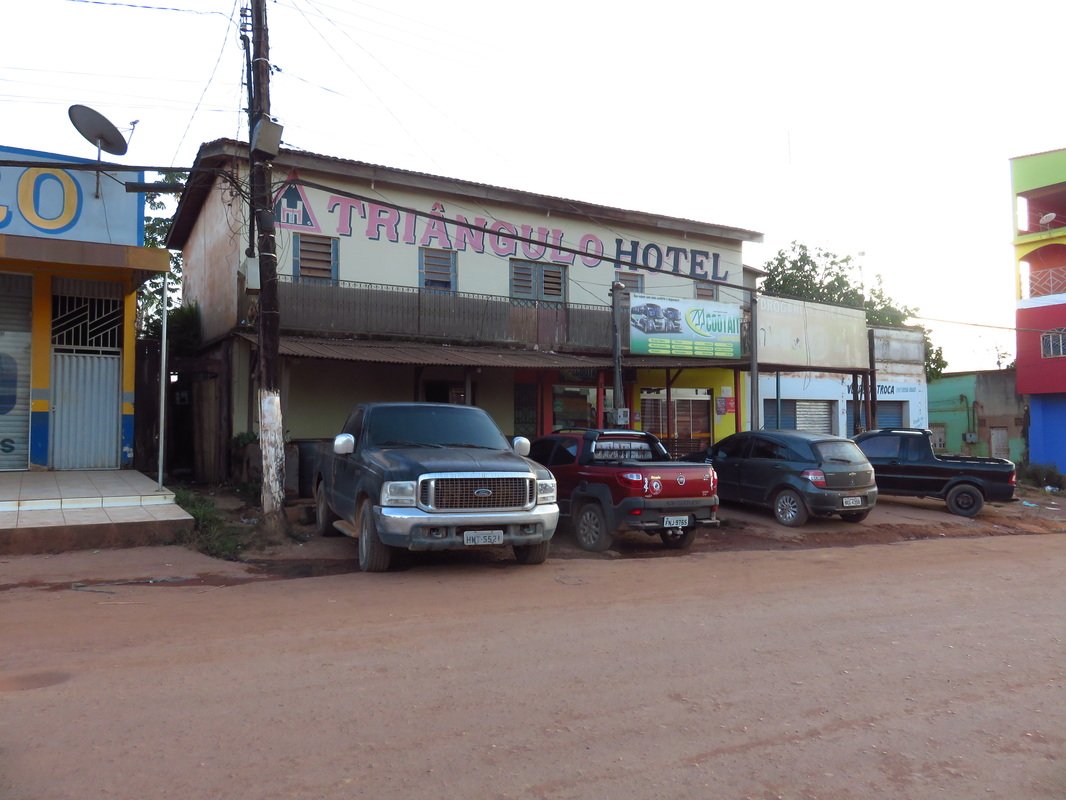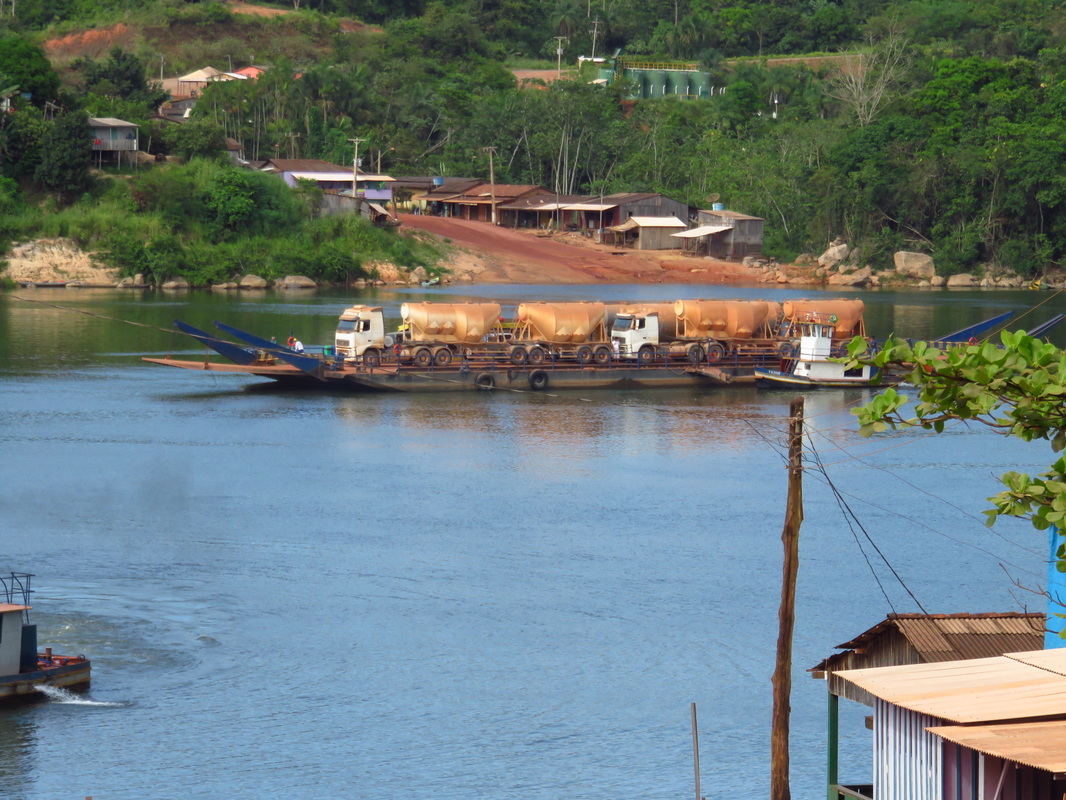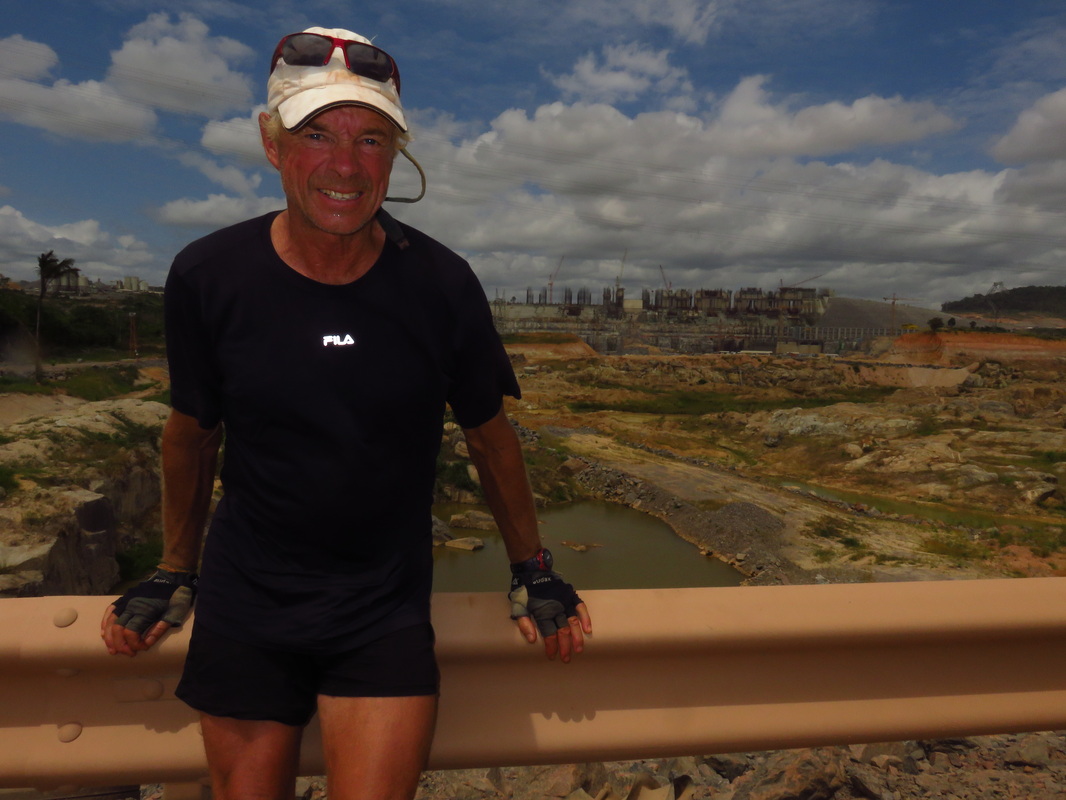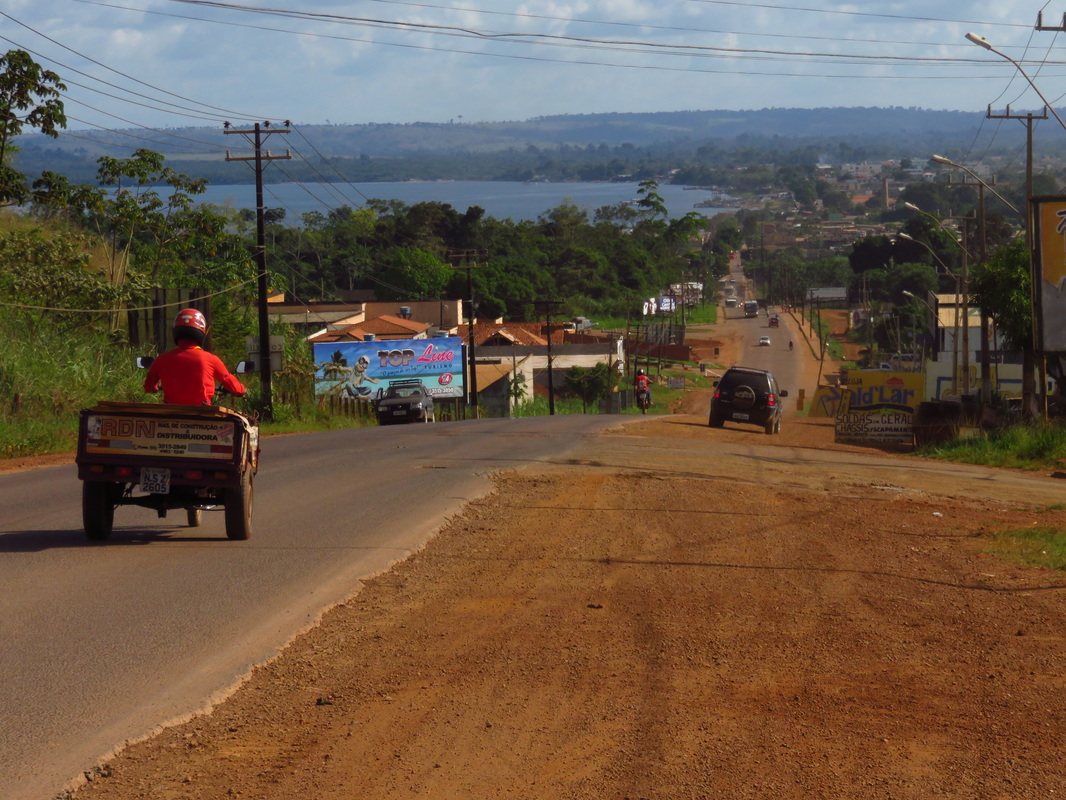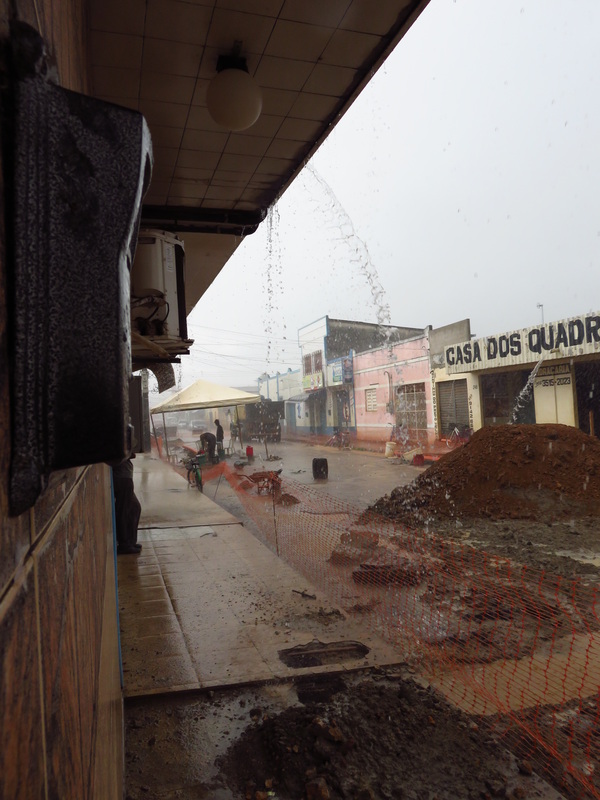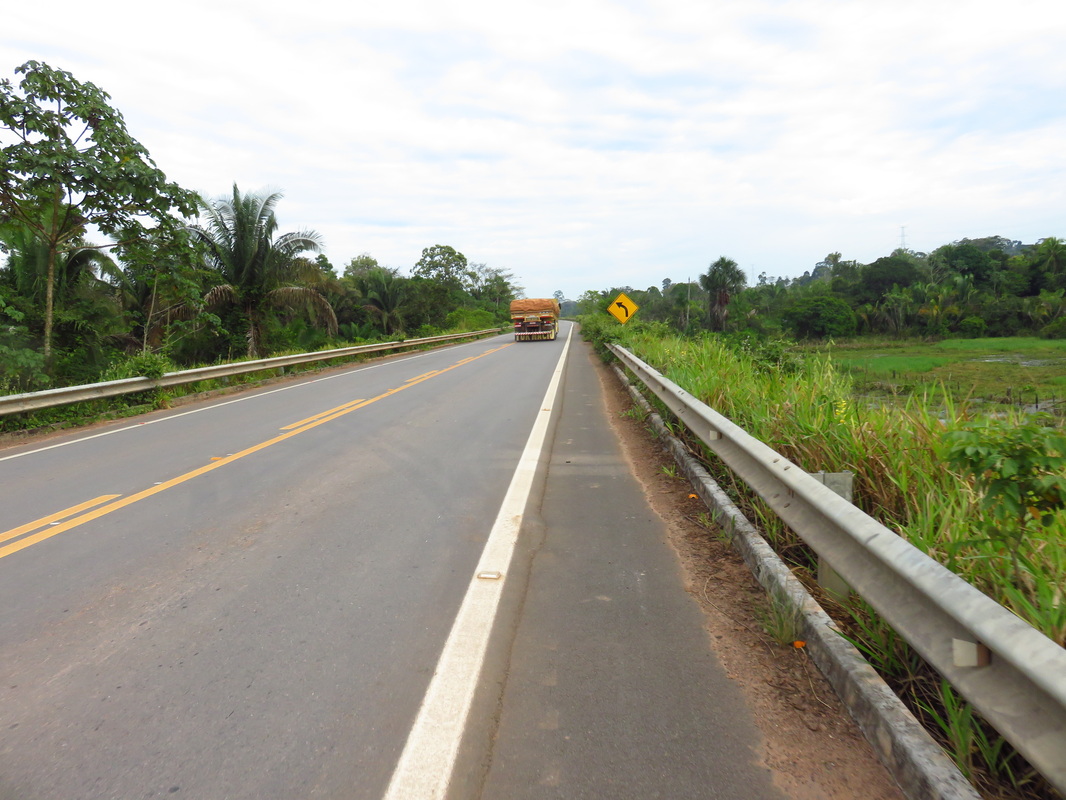With no disrespect to Brazil or its people. This song by Chris Rea pretty well sums up what I have seen to date on The Trans Amazonica.
To the natural environment, the animals, other life and indigenous peoples who lived in harmony here in the Amazon basin. This is what I feel this road must represent for them.
Not so, to the new comers.
As humans. Of late, we have instinctively destroyed and changed almost all new environments and landscapes we have occupied on this planet.
Sadly, it is what we do, we are good at it, and as our numbers increase, we will probably do it with more urgency and even less consideration to the ensuing consequences.
I feel the time is nearing when the natural undisturbed parts of our planet will become more of an asset than any city will ever be.
Unlike lands in our developed countries, this land is still weeping from the pain it has and is still enduring.
I can feel it, as I ride along, fresh scars in the landscape, stagnant water courses, blocked by the road, lonely trees and Babacu palms in paddocks, Macaque Monkeys calling from isolated pockets of jungle and the smell of smoke. Clouds of dust like blood from a wound.
Having expressed these sentiments, what the Brasileiros have done here in the Amazon Basin, is quite amazing, given the conditions and isolation. Their intentions are for the good of their people.
The inspiration to ride and continue to ride along it comes from the human endeavour and endurance witnessed along the way.
( Chris Rea wrote the song in 1989 about traffic jams on the London Orbital Motorway, M25)
As I was composing the opening lines to this entry, just about to upload them to the internet.
A tropical storm could be heard outside, heavy rain and thunder. Then all of a sudden my room shook as a deafening clap of thunder roared and pieces of tiles fell into my bathroom. Then the water started coming in. By now, the room was very dark without lights.
Needless to say, it took out the power.
Water was pouring in through the timbered ceiling. A lightening strike had blown a hole in the roof above my room.
Within 10 minutes, the floor was 10mm deep in water. Hurriedly I packed things back in the panniers to protect them.
It was nature was saying, “It’s ok, I’m still here”.
3/8/2014 Pacajá to catholic church
30km north of Anapu
D109, T10, Av15.91, max63 31455/5920
Moist haze in ranges, overcast 30+
With the wall fan howling all night in my “cell” just to stop the mossies from landing on me, a full nights sleep was difficult. They must approach from the ground and use the bed for shelter from the turbulent air. The first targets they usually find are my fingers. Awakening and having terribly itchy spots on the sides them indicates the possibility of this flight path. Their instinctual need for blood seems to always get them to their host.
Given all this, I was up at 0500, had a cold shower. Even though it is probably 24 degrees in the morning, it is always a shock getting a drenching from cold water. On the count of four it is straight under, the initial chill is a rush, though moments later the refreshing feeling kicks in and it all feels oh so good.
I had the norm for brekky and was on the road at 0715. The day was remarkably mild, it was overcast and the air had a coolness about it.
The town had a smokey haze lingering above it.
Riding was a pleasure on the asphalt. This disappeared after 10km and dirt continued on into Bom Jardim.
Many of the cement trucks were tooting me, as they had seen me on the road now during both their delivery and return trips.
A stop was made at a classic little bar, it had a dirt floor and adobe walls, there was a bunch of guys drinking rum among other brews there.
One of them shouted me a drink. Outside there was a wooden bridge on the road spanning a small creek, it was in bad repair. I watched a semi crossing it, the whole structure, right down to the piles in the creek were swaying.
It was being crossed, with much caution by all truck drivers.
Nearing Bom Jardim, in a deep cutting with a wide section of road through it.
A lady was selling Bolo, a sweet cake here. I had a couple of pieces of this and a black coffee.
She told me they had 25 acres and grew cacao, this area was popular for growing cacao, it was hilly.
She had a neat little dog called Madonna, They have great dog names here. Pablo and Madonna, in two days.
In Bom Jardim, lunch of pork chicharon, rice and salad was enjoyed.
This town was again like a wild west set. There were assorted shops on both sides of the wide dirt road, some closed, some open and all in a state of disrepair.
I found a restaurant in a rotunda type of set up in the middle of the road. It was the kind of place where two guys turned up on a moto with two chickens tied together by their feet. A deal was done amongst us diners and the owner wanders past with these two highly distressed birds and drops them over the hand rail by a table. Tomorrows menu was waiting to be dispatched.
After my meal I got up and went and had a look at these birds. They were upside down now with a stick running between their legs, two more were with them. They were breathing heavily with open beaks.
A sack was moving nearby, who knows what was in there.
This side of eating is never even remotely considered when eating food at home in our societies that are so far detached from reality. Meat is like something that was never living.
One thing is for sure, these birds at least had a free life, wandering about, pecking away as they do and possibly rearing young in the back yard.
This life leads to a great flavoursome meat.
Whilst on this topic of detachment from reality. I guess today, many people in big cities don’t even know what it is like to get wet in rain.
On a wet day they get up, climb into the car drive to the high-rise office, park the car in the underground carpark and take the lift to the office and do the same on the way home.
Their life is such where they are so far detached from the natural world that the weather really has nothing to do with their existence.
Excitement in their life, in many cases revolves around material purchases or money. Or, their next escape from their sublimely monotonous lives. An escape called a holiday for lack of a better term.
It is quite scary, thinking about what one human being with a reasonable amount of money is capable of consuming in their lifetime. It will be interesting to see what happens when consumerism amongst many of the 3 billion Indians and Chinese becomes the norm.
Maybe, many more people in our societies will see their is another way to enjoy life without surrounding themselves in big houses full of electrical stuff that is obsolete almost as soon as they get it home.
Back to proceedings, a driver in the restaurant told me it was 10km to the asphalt.
There were lots of road works being carried out, many previous steep little climbs following the contours of the land were being cut.
Sure enough, after 10km, I was back on tar, it was a pleasure, that of smooth road mat type asphalt.
I was covered in dust. Soon in Anapu, I stopped and had a break for an hour. Back on the road with a full load of water. I needed to find a creek to wash freshen up . Evidently the road now was all paved to Altamira.
A creek was soon found that had access from the road. Careful not to put too much of my body in the murky waters, most of the dust was removed. I also stripped off and washed all my clothes.
It felt so good to be dust free and clock up good k’s on the 2 year old road.
The section of BR230 ridden so far has been tough in parts but not for long periods, to date, two days at the most. The government really are improving this road at great rate.
Just two years ago, from here back Novo Repartimento would have all been dirt.
At about 1730, I was out of energy, a small pueblito was encountered, I pulled and asked some people if I could camp behind the local evangelical church.
They were all just enjoying the cool afternoon air on porches decks.
One of them, Antonio, said I could stay in the little catholic church down the road.
He took me there, he rode his moto. He had the keys. It was unreal, I had use of the little church, with electricity and all the comforts of being indoors.
He took me to a creek on his moto and said I could wash there.
During my travels here in South America, churches of all denominations have been such fantastic and welcoming refuges.
Some of the most comfortable, safe nights have been in their grounds or indoors.
Though not religious by any means, the goodwill and kindness of all involved with those properties slept at in the last few years has been overwhelming to say the least.
Thankyou, so much.
Once settled in, I put the tent up to act as a mossy screen, repaired a couple of things on the bike. Had a good read and promptly fell asleep.
Thanks so much Antonio, I felt safe and secure.
4/8/2014 Church to Altamira
D119, T12, Av18, Max76, 31,574/6039
Hot, late 30’s, little wind
I dropped the keys back to Antonios friend and got on the move about 0745.
A creaking whilst riding had gone. Last night I had removed both pedals again and greased the threads. This noise often spoilt the silence when no traffic was about.
The riding again was easy, good surface, good shoulder and not too much traffic.
With some music playing and an average speed of 20+, things couldn’t be better.
People were on the roadside waiting for buses. Always acknowledging them, some enthusiastically respond others are otherwise occupied and others can’t figure me out.
Soon a sign indicating Belo Monte was 10km up ahead, then one for 5km. Thinking to myself what is all this about. Come the 10km mark, arriving in Belo Monte. It was the embarkment point for a ferry across the Rio Xingu.
I’m not one for wanting to know exactly where I am too often. My paper maps are photocopies and not to clear.
What a huge river, this made such a welcome break in the trip.
The ferry was on the other side of the river, coming our way loaded with empty cement trucks.
Once against the southern shore we embarked, we included lots of motos, foot passengers, cars and trucks. It was a large ferry.
Half way across dolphins were seen near the boat, it was absolutely unreal this far inland. They were the Amazon dolphin with the unique head shape.
Once on the north bank in Belo Monte 2, I had a few drinks and empanadas in a small store.
The road from here was hard work, like back in Misiones in AR, with quite large climbs and just as big descents.
Todays top speed indicates this.
Some 20km on. I came to the construction area of hte new Rio Xingu hydro dam.
What a sight, cranes pointed skyward in the distance perched atop a huge concrete structure with shaped bedrock at its base.
Where the road was taking me would be a couple of hundred feet underwater a 3 or 4 years time.
Belo Monte Dam From Wikipedia, the free encyclopedia
The Belo Monte Dam (formerly known as Kararaô) is a hydroelectric dam complex currently under construction on the Xingu River in the state of Pará, Brazil. The planned installed capacity of the dam complex would be 11,233 megawatts (MW), which would make it the second-largest hydroelectric dam complex in Brazil and one of the world's largest in installed capacity, behind the Three Gorges Dam in China and the Brazilian-Paraguayan Itaipu Dam. Considering the oscillations of flow river, guaranteed minimum capacity generation from the Belo Monte Dam would measure 4,571 MW, 39% of its maximum capacity.[2] Transmission lines would connect electricity generated by the dams' turbines to the main Brazilian power grid, which would distribute it throughout the country, both for residential and commercial consumption and to supply the growth of such industries as aluminium transformation and metallurgy. Brazil's rapid economic growth over the last decade has provoked a huge demand for new and stable sources of energy, especially to supply its growing industries. In Brazil, 46% of the energy consumed comes from renewable energy sources, and hydroelectric power plants produce over 85% of the electrical energy. The Government has decided to construct new hydroelectric dams to guarantee national energy security.
However, there is opposition both within Brazil and among the international community to the project's potential construction regarding its economic viability, the generation efficiency of the dams and in particular its impacts on the region's people and environment. In addition, critics worry that construction of the Belo Monte Dam could make the construction of other dams upstream, which could have greater impacts, more viable.
Plans for the dam began in 1975 but were soon shelved due to controversy; they were later revitalized in the late 1990s. In the 2000s, the dam was redesigned, but faced renewed controversy and (controversial) impact assessments were carried out. On 26 August 2010, a contract was signed with Norte Energia to construct the dam once the Brazilian Institute of Environment and Renewable Natural Resources (IBAMA) had issued an installation license. A partial installation license was granted on 26 January 2011 and a full license to construct the dam was issued on 1 June 2011. The licensing process and the dam's construction have been mired in federal court battles; the current ruling is that construction is allowed, because the license is based on five different environmental technical reports[3] and in accordance with the RIMA (Environmental Impact Report, EIA-RIMA) study for Belo Monte.[4]
History Plans for what would eventually be called the Belo Monte Dam Complex began in 1975 during Brazil's military dictatorship, when Eletronorte contracted the Consórcio Nacional de Engenheiros Consultores (CNEC) to realize a hydrographic study to locate potential sites for a hydroelectric project on the Xingu River. CNEC completed its study in 1979 and identified the possibility of constructing five dams on the Xingu River and one dam on the Iriri River.[5]
Original plans for the project based on the 1979 study included two dams close to Belo Monte. These were: Kararaô (called Belo Monte after 1989), Babaquara (called Altamira after 1998) which was the next upstream.[5] Four other dams were planned upstream as well and they include the Ipixuna, Kakraimoro, Iriri and Jarina. The project was part of Eletrobras' "2010 Plan" which included 297 dams that were to be constructed in Brazil by 2010. The plan was leaked early and officially released in December 1987 to an antagonistic public. The plan had Belo Monte to be constructed by 2000 and Altamira by 2005. Such a speedy timetable was due to the belief that Brazil's relatively new environmental regulations could not stop large projects.[6] The government offered little transparency to the people who would be affected regarding its plans for the hydroelectric project, provoking indigenous tribes of the region to organize what they called the I Encontro das Nações Indígenas do Xingu (First Encounter of the Indigenous Nations of the Xingu) or the "Altamira Gathering", in 1989. The encounter, symbolized by the indigenous woman leader Tuíra holding her machete against the face of then-engineer José Antonio Muniz Lopes sparked enormous repercussions both in Brazil and internationally over the plans for the six dams. As a result, the five dams above Belo Monte were removed from planning and Kararaô was renamed to Belo Monte at the request of the people of that tribe. Eletronorte also stated they would "resurvey the fall", meaning resurvey the dams on the river.[6][7]
Redesign Between 1989 and 2002, the Belo Monte project was redesigned. The reservoir's surface area was reduced from 1,225 km2 (473 sq mi) to 440 km2 (170 sq mi) by moving the dam further upstream. The main rationale for this was to reduce flooding of the Bacajá Indigenous Area. In 1998, the Babaquara Dam was again placed into planning but under a new name, the Altamira Dam. This surprised local leaders as they felt plans for the dams above Belo Monte were cancelled. Some officials in Brazil were determined to build a dam on a river with an average flow of 7,800 m3/s (275,454 cu ft/s) and at a site that offers a 87.5 m (287 ft) drop. One engineer said of the dam: "God only makes a place like Belo Monte once in a while. This place was made for a dam."[6] President of Eletronorte, José Muniz Lopes, in an interview with the newspaper O Liberal (Belo Monte entusiasma an Eletronorte por Sônia Zaghetto, 15 July 2001), affirmed:
"Within the electric sector's planning for the period 2010/2020, we’re looking at three dams – Marabá (Tocantins river), Altamira (previously called Babaquara, Xingu River) and Itaituba (São Luís do Tapajós). Some journalists say that we are not talking about these dams because we’re trying to hide them. It’s just that their time has not yet come. We’re now asking for authorization to intensify our studies for these dams. Brazil would be greatly benefited if we could follow Belo Monte with Marabá, then Altamira and Itaituba."
To the left of the huge partly completed monolith was the cement works where all those trucks discharged their powdery cargo.
The Rio Xingu, is a huge slow moving river at this point, crossing in the ferry it was hard even to see what way it flowed, such is the volume of water.
From here it was a case of riding through a construction site, with workers villages and tracks everywhere.
From here, I stopped at a ne Petrobras gas station and got water.
The heat of the day was upon me. I really wanted to get to Altamira as my dad is not to well and I needed to be in touch.
In this respect I was riding with just a bit of urgency, which in many respects is not good.
The climbing was getting harder and harder.
Soon I came upon a Lanchonette, here they showed me to the tap. It was waist high. Putting it on full flow, I sat under it and just let the warmish water drench me.
Lunch was ordered, though basic, chicken, beans and rice it was so good.
Time was spent chatting to a few drivers about the road.
Once again it was all hills with 30km to Altamira.
At about 1500, the city limits were entered. All the way from the new dam to town, every 5 minutes a bus was ferrying workers to the work site. It is a twenty four hour operation. Once the wet kicks in many tasks become impossible.
Coming to the top of hte last climb to town, it was a pleasure looking down hill to the blue waters of this huge tributary of the Amazon river.
Once in town on the foreshores, people at the lanchonette had told me of a cheap hotel here, I spotted an ice cream sop overlooking the river, they had my favourite flavour.
Two tubs of Menta Granazada were eaten like it was my first meal in a month, they were divine.
A good friend in phoned US was phoned as were my parents.
At the Bela Vista hotel they were full. Infact every hotel visited was full. The only places with vacancies were upper end lodgings. In my position a waste of money.
Though not concerned I found myself still looking for a hotel at 2000 in hte dark, though always with the lit streets. I went back to the Bela Vista and asked if he knew of a place. The Plaza he said. Having directions,I pulled in , they had a room with 2 single and ne dudle bed with a shower and toilet and a fan.
At 40 dollars a night. I grabbed it. It was so good to be off the streets.
All of a sudden I realised how worn out I was. I had a shower lay down. At 2130 wandered down the road for a beer and food.
Once back at the room I stacked up 3 pillows on my bed in a comfortable way, put the fan on, fell onto the bed, that is all that is remembered.
Altamira is a city in the state of Pará, in northern Brazil. It is the largest municipality in the Americas by area, and the second in the world, after Jiuquan, China. It the home of the Territorial Prelature of Xingu.
If Altamira were a country, it would be the 91st largest, bigger than Greece and Nepal and almost the size of Tunisia and Uruguay.
Altamira is served by Altamira Airport.
Economy The municipal GDP is around US$ 450 million and is mainly linked to agricultural activities, trade and since 2010 has been driven by the construction of the Belo Monte Dam.
Belo Monte Dam In Altamira the 3rd largest dam in the world (by generating capacity (behind Three Gorges Dam and Itaipu Dam), with a capacity of 11.233 MW/h) is being built; the construction work was started in 2010 and should be completed in 2019.
Geography Altamira is located in a transition area between the Brazilian Highlands and Amazonian Lowlands, is situated on the shores of the Xingu River a tributary of the Amazon River, with average elevation of 109 meters. This is the 2nd largest city in the world in land area.
Climate The climate of Altamira is tropical humid, with high temperatures all year and average rainfall of 2150 mm (84 inches) annually. The seasons are undefined, with only change in rainfall rate.
Winters are warm and rainy, with lows between 19°C and 22°C and highs of 26°C and 35°C.
Summers are warmer and drier with lows between 22°C and 26°C and highs of 30°C and 40°C.
To the natural environment, the animals, other life and indigenous peoples who lived in harmony here in the Amazon basin. This is what I feel this road must represent for them.
Not so, to the new comers.
As humans. Of late, we have instinctively destroyed and changed almost all new environments and landscapes we have occupied on this planet.
Sadly, it is what we do, we are good at it, and as our numbers increase, we will probably do it with more urgency and even less consideration to the ensuing consequences.
I feel the time is nearing when the natural undisturbed parts of our planet will become more of an asset than any city will ever be.
Unlike lands in our developed countries, this land is still weeping from the pain it has and is still enduring.
I can feel it, as I ride along, fresh scars in the landscape, stagnant water courses, blocked by the road, lonely trees and Babacu palms in paddocks, Macaque Monkeys calling from isolated pockets of jungle and the smell of smoke. Clouds of dust like blood from a wound.
Having expressed these sentiments, what the Brasileiros have done here in the Amazon Basin, is quite amazing, given the conditions and isolation. Their intentions are for the good of their people.
The inspiration to ride and continue to ride along it comes from the human endeavour and endurance witnessed along the way.
( Chris Rea wrote the song in 1989 about traffic jams on the London Orbital Motorway, M25)
As I was composing the opening lines to this entry, just about to upload them to the internet.
A tropical storm could be heard outside, heavy rain and thunder. Then all of a sudden my room shook as a deafening clap of thunder roared and pieces of tiles fell into my bathroom. Then the water started coming in. By now, the room was very dark without lights.
Needless to say, it took out the power.
Water was pouring in through the timbered ceiling. A lightening strike had blown a hole in the roof above my room.
Within 10 minutes, the floor was 10mm deep in water. Hurriedly I packed things back in the panniers to protect them.
It was nature was saying, “It’s ok, I’m still here”.
3/8/2014 Pacajá to catholic church
30km north of Anapu
D109, T10, Av15.91, max63 31455/5920
Moist haze in ranges, overcast 30+
With the wall fan howling all night in my “cell” just to stop the mossies from landing on me, a full nights sleep was difficult. They must approach from the ground and use the bed for shelter from the turbulent air. The first targets they usually find are my fingers. Awakening and having terribly itchy spots on the sides them indicates the possibility of this flight path. Their instinctual need for blood seems to always get them to their host.
Given all this, I was up at 0500, had a cold shower. Even though it is probably 24 degrees in the morning, it is always a shock getting a drenching from cold water. On the count of four it is straight under, the initial chill is a rush, though moments later the refreshing feeling kicks in and it all feels oh so good.
I had the norm for brekky and was on the road at 0715. The day was remarkably mild, it was overcast and the air had a coolness about it.
The town had a smokey haze lingering above it.
Riding was a pleasure on the asphalt. This disappeared after 10km and dirt continued on into Bom Jardim.
Many of the cement trucks were tooting me, as they had seen me on the road now during both their delivery and return trips.
A stop was made at a classic little bar, it had a dirt floor and adobe walls, there was a bunch of guys drinking rum among other brews there.
One of them shouted me a drink. Outside there was a wooden bridge on the road spanning a small creek, it was in bad repair. I watched a semi crossing it, the whole structure, right down to the piles in the creek were swaying.
It was being crossed, with much caution by all truck drivers.
Nearing Bom Jardim, in a deep cutting with a wide section of road through it.
A lady was selling Bolo, a sweet cake here. I had a couple of pieces of this and a black coffee.
She told me they had 25 acres and grew cacao, this area was popular for growing cacao, it was hilly.
She had a neat little dog called Madonna, They have great dog names here. Pablo and Madonna, in two days.
In Bom Jardim, lunch of pork chicharon, rice and salad was enjoyed.
This town was again like a wild west set. There were assorted shops on both sides of the wide dirt road, some closed, some open and all in a state of disrepair.
I found a restaurant in a rotunda type of set up in the middle of the road. It was the kind of place where two guys turned up on a moto with two chickens tied together by their feet. A deal was done amongst us diners and the owner wanders past with these two highly distressed birds and drops them over the hand rail by a table. Tomorrows menu was waiting to be dispatched.
After my meal I got up and went and had a look at these birds. They were upside down now with a stick running between their legs, two more were with them. They were breathing heavily with open beaks.
A sack was moving nearby, who knows what was in there.
This side of eating is never even remotely considered when eating food at home in our societies that are so far detached from reality. Meat is like something that was never living.
One thing is for sure, these birds at least had a free life, wandering about, pecking away as they do and possibly rearing young in the back yard.
This life leads to a great flavoursome meat.
Whilst on this topic of detachment from reality. I guess today, many people in big cities don’t even know what it is like to get wet in rain.
On a wet day they get up, climb into the car drive to the high-rise office, park the car in the underground carpark and take the lift to the office and do the same on the way home.
Their life is such where they are so far detached from the natural world that the weather really has nothing to do with their existence.
Excitement in their life, in many cases revolves around material purchases or money. Or, their next escape from their sublimely monotonous lives. An escape called a holiday for lack of a better term.
It is quite scary, thinking about what one human being with a reasonable amount of money is capable of consuming in their lifetime. It will be interesting to see what happens when consumerism amongst many of the 3 billion Indians and Chinese becomes the norm.
Maybe, many more people in our societies will see their is another way to enjoy life without surrounding themselves in big houses full of electrical stuff that is obsolete almost as soon as they get it home.
Back to proceedings, a driver in the restaurant told me it was 10km to the asphalt.
There were lots of road works being carried out, many previous steep little climbs following the contours of the land were being cut.
Sure enough, after 10km, I was back on tar, it was a pleasure, that of smooth road mat type asphalt.
I was covered in dust. Soon in Anapu, I stopped and had a break for an hour. Back on the road with a full load of water. I needed to find a creek to wash freshen up . Evidently the road now was all paved to Altamira.
A creek was soon found that had access from the road. Careful not to put too much of my body in the murky waters, most of the dust was removed. I also stripped off and washed all my clothes.
It felt so good to be dust free and clock up good k’s on the 2 year old road.
The section of BR230 ridden so far has been tough in parts but not for long periods, to date, two days at the most. The government really are improving this road at great rate.
Just two years ago, from here back Novo Repartimento would have all been dirt.
At about 1730, I was out of energy, a small pueblito was encountered, I pulled and asked some people if I could camp behind the local evangelical church.
They were all just enjoying the cool afternoon air on porches decks.
One of them, Antonio, said I could stay in the little catholic church down the road.
He took me there, he rode his moto. He had the keys. It was unreal, I had use of the little church, with electricity and all the comforts of being indoors.
He took me to a creek on his moto and said I could wash there.
During my travels here in South America, churches of all denominations have been such fantastic and welcoming refuges.
Some of the most comfortable, safe nights have been in their grounds or indoors.
Though not religious by any means, the goodwill and kindness of all involved with those properties slept at in the last few years has been overwhelming to say the least.
Thankyou, so much.
Once settled in, I put the tent up to act as a mossy screen, repaired a couple of things on the bike. Had a good read and promptly fell asleep.
Thanks so much Antonio, I felt safe and secure.
4/8/2014 Church to Altamira
D119, T12, Av18, Max76, 31,574/6039
Hot, late 30’s, little wind
I dropped the keys back to Antonios friend and got on the move about 0745.
A creaking whilst riding had gone. Last night I had removed both pedals again and greased the threads. This noise often spoilt the silence when no traffic was about.
The riding again was easy, good surface, good shoulder and not too much traffic.
With some music playing and an average speed of 20+, things couldn’t be better.
People were on the roadside waiting for buses. Always acknowledging them, some enthusiastically respond others are otherwise occupied and others can’t figure me out.
Soon a sign indicating Belo Monte was 10km up ahead, then one for 5km. Thinking to myself what is all this about. Come the 10km mark, arriving in Belo Monte. It was the embarkment point for a ferry across the Rio Xingu.
I’m not one for wanting to know exactly where I am too often. My paper maps are photocopies and not to clear.
What a huge river, this made such a welcome break in the trip.
The ferry was on the other side of the river, coming our way loaded with empty cement trucks.
Once against the southern shore we embarked, we included lots of motos, foot passengers, cars and trucks. It was a large ferry.
Half way across dolphins were seen near the boat, it was absolutely unreal this far inland. They were the Amazon dolphin with the unique head shape.
Once on the north bank in Belo Monte 2, I had a few drinks and empanadas in a small store.
The road from here was hard work, like back in Misiones in AR, with quite large climbs and just as big descents.
Todays top speed indicates this.
Some 20km on. I came to the construction area of hte new Rio Xingu hydro dam.
What a sight, cranes pointed skyward in the distance perched atop a huge concrete structure with shaped bedrock at its base.
Where the road was taking me would be a couple of hundred feet underwater a 3 or 4 years time.
Belo Monte Dam From Wikipedia, the free encyclopedia
The Belo Monte Dam (formerly known as Kararaô) is a hydroelectric dam complex currently under construction on the Xingu River in the state of Pará, Brazil. The planned installed capacity of the dam complex would be 11,233 megawatts (MW), which would make it the second-largest hydroelectric dam complex in Brazil and one of the world's largest in installed capacity, behind the Three Gorges Dam in China and the Brazilian-Paraguayan Itaipu Dam. Considering the oscillations of flow river, guaranteed minimum capacity generation from the Belo Monte Dam would measure 4,571 MW, 39% of its maximum capacity.[2] Transmission lines would connect electricity generated by the dams' turbines to the main Brazilian power grid, which would distribute it throughout the country, both for residential and commercial consumption and to supply the growth of such industries as aluminium transformation and metallurgy. Brazil's rapid economic growth over the last decade has provoked a huge demand for new and stable sources of energy, especially to supply its growing industries. In Brazil, 46% of the energy consumed comes from renewable energy sources, and hydroelectric power plants produce over 85% of the electrical energy. The Government has decided to construct new hydroelectric dams to guarantee national energy security.
However, there is opposition both within Brazil and among the international community to the project's potential construction regarding its economic viability, the generation efficiency of the dams and in particular its impacts on the region's people and environment. In addition, critics worry that construction of the Belo Monte Dam could make the construction of other dams upstream, which could have greater impacts, more viable.
Plans for the dam began in 1975 but were soon shelved due to controversy; they were later revitalized in the late 1990s. In the 2000s, the dam was redesigned, but faced renewed controversy and (controversial) impact assessments were carried out. On 26 August 2010, a contract was signed with Norte Energia to construct the dam once the Brazilian Institute of Environment and Renewable Natural Resources (IBAMA) had issued an installation license. A partial installation license was granted on 26 January 2011 and a full license to construct the dam was issued on 1 June 2011. The licensing process and the dam's construction have been mired in federal court battles; the current ruling is that construction is allowed, because the license is based on five different environmental technical reports[3] and in accordance with the RIMA (Environmental Impact Report, EIA-RIMA) study for Belo Monte.[4]
History Plans for what would eventually be called the Belo Monte Dam Complex began in 1975 during Brazil's military dictatorship, when Eletronorte contracted the Consórcio Nacional de Engenheiros Consultores (CNEC) to realize a hydrographic study to locate potential sites for a hydroelectric project on the Xingu River. CNEC completed its study in 1979 and identified the possibility of constructing five dams on the Xingu River and one dam on the Iriri River.[5]
Original plans for the project based on the 1979 study included two dams close to Belo Monte. These were: Kararaô (called Belo Monte after 1989), Babaquara (called Altamira after 1998) which was the next upstream.[5] Four other dams were planned upstream as well and they include the Ipixuna, Kakraimoro, Iriri and Jarina. The project was part of Eletrobras' "2010 Plan" which included 297 dams that were to be constructed in Brazil by 2010. The plan was leaked early and officially released in December 1987 to an antagonistic public. The plan had Belo Monte to be constructed by 2000 and Altamira by 2005. Such a speedy timetable was due to the belief that Brazil's relatively new environmental regulations could not stop large projects.[6] The government offered little transparency to the people who would be affected regarding its plans for the hydroelectric project, provoking indigenous tribes of the region to organize what they called the I Encontro das Nações Indígenas do Xingu (First Encounter of the Indigenous Nations of the Xingu) or the "Altamira Gathering", in 1989. The encounter, symbolized by the indigenous woman leader Tuíra holding her machete against the face of then-engineer José Antonio Muniz Lopes sparked enormous repercussions both in Brazil and internationally over the plans for the six dams. As a result, the five dams above Belo Monte were removed from planning and Kararaô was renamed to Belo Monte at the request of the people of that tribe. Eletronorte also stated they would "resurvey the fall", meaning resurvey the dams on the river.[6][7]
Redesign Between 1989 and 2002, the Belo Monte project was redesigned. The reservoir's surface area was reduced from 1,225 km2 (473 sq mi) to 440 km2 (170 sq mi) by moving the dam further upstream. The main rationale for this was to reduce flooding of the Bacajá Indigenous Area. In 1998, the Babaquara Dam was again placed into planning but under a new name, the Altamira Dam. This surprised local leaders as they felt plans for the dams above Belo Monte were cancelled. Some officials in Brazil were determined to build a dam on a river with an average flow of 7,800 m3/s (275,454 cu ft/s) and at a site that offers a 87.5 m (287 ft) drop. One engineer said of the dam: "God only makes a place like Belo Monte once in a while. This place was made for a dam."[6] President of Eletronorte, José Muniz Lopes, in an interview with the newspaper O Liberal (Belo Monte entusiasma an Eletronorte por Sônia Zaghetto, 15 July 2001), affirmed:
"Within the electric sector's planning for the period 2010/2020, we’re looking at three dams – Marabá (Tocantins river), Altamira (previously called Babaquara, Xingu River) and Itaituba (São Luís do Tapajós). Some journalists say that we are not talking about these dams because we’re trying to hide them. It’s just that their time has not yet come. We’re now asking for authorization to intensify our studies for these dams. Brazil would be greatly benefited if we could follow Belo Monte with Marabá, then Altamira and Itaituba."
To the left of the huge partly completed monolith was the cement works where all those trucks discharged their powdery cargo.
The Rio Xingu, is a huge slow moving river at this point, crossing in the ferry it was hard even to see what way it flowed, such is the volume of water.
From here it was a case of riding through a construction site, with workers villages and tracks everywhere.
From here, I stopped at a ne Petrobras gas station and got water.
The heat of the day was upon me. I really wanted to get to Altamira as my dad is not to well and I needed to be in touch.
In this respect I was riding with just a bit of urgency, which in many respects is not good.
The climbing was getting harder and harder.
Soon I came upon a Lanchonette, here they showed me to the tap. It was waist high. Putting it on full flow, I sat under it and just let the warmish water drench me.
Lunch was ordered, though basic, chicken, beans and rice it was so good.
Time was spent chatting to a few drivers about the road.
Once again it was all hills with 30km to Altamira.
At about 1500, the city limits were entered. All the way from the new dam to town, every 5 minutes a bus was ferrying workers to the work site. It is a twenty four hour operation. Once the wet kicks in many tasks become impossible.
Coming to the top of hte last climb to town, it was a pleasure looking down hill to the blue waters of this huge tributary of the Amazon river.
Once in town on the foreshores, people at the lanchonette had told me of a cheap hotel here, I spotted an ice cream sop overlooking the river, they had my favourite flavour.
Two tubs of Menta Granazada were eaten like it was my first meal in a month, they were divine.
A good friend in phoned US was phoned as were my parents.
At the Bela Vista hotel they were full. Infact every hotel visited was full. The only places with vacancies were upper end lodgings. In my position a waste of money.
Though not concerned I found myself still looking for a hotel at 2000 in hte dark, though always with the lit streets. I went back to the Bela Vista and asked if he knew of a place. The Plaza he said. Having directions,I pulled in , they had a room with 2 single and ne dudle bed with a shower and toilet and a fan.
At 40 dollars a night. I grabbed it. It was so good to be off the streets.
All of a sudden I realised how worn out I was. I had a shower lay down. At 2130 wandered down the road for a beer and food.
Once back at the room I stacked up 3 pillows on my bed in a comfortable way, put the fan on, fell onto the bed, that is all that is remembered.
Altamira is a city in the state of Pará, in northern Brazil. It is the largest municipality in the Americas by area, and the second in the world, after Jiuquan, China. It the home of the Territorial Prelature of Xingu.
If Altamira were a country, it would be the 91st largest, bigger than Greece and Nepal and almost the size of Tunisia and Uruguay.
Altamira is served by Altamira Airport.
Economy The municipal GDP is around US$ 450 million and is mainly linked to agricultural activities, trade and since 2010 has been driven by the construction of the Belo Monte Dam.
Belo Monte Dam In Altamira the 3rd largest dam in the world (by generating capacity (behind Three Gorges Dam and Itaipu Dam), with a capacity of 11.233 MW/h) is being built; the construction work was started in 2010 and should be completed in 2019.
Geography Altamira is located in a transition area between the Brazilian Highlands and Amazonian Lowlands, is situated on the shores of the Xingu River a tributary of the Amazon River, with average elevation of 109 meters. This is the 2nd largest city in the world in land area.
Climate The climate of Altamira is tropical humid, with high temperatures all year and average rainfall of 2150 mm (84 inches) annually. The seasons are undefined, with only change in rainfall rate.
Winters are warm and rainy, with lows between 19°C and 22°C and highs of 26°C and 35°C.
Summers are warmer and drier with lows between 22°C and 26°C and highs of 30°C and 40°C.
|
|
